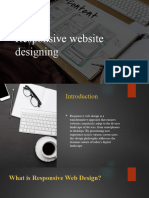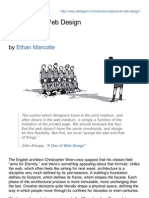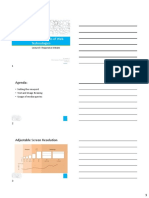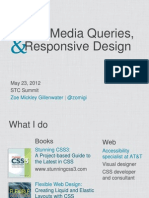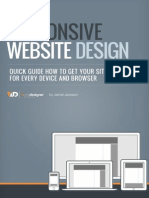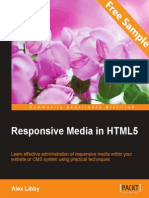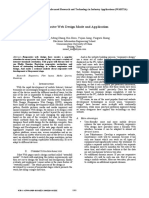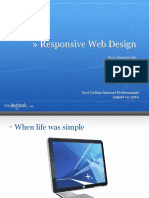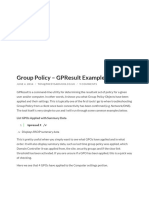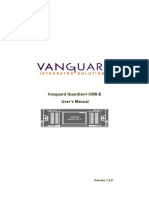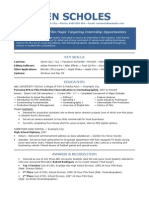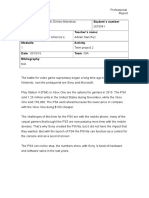K.L.E.
SOCIETY'S
K.L.E. INSTITUTE OF TECHNOLOGY
Computer Science and Engineering, Hubli
Case Study Report
On
Responsive Web Design
Using CSS Media Queries
Title: Case Study on Responsive Web Design Using CSS Media Queries
Student Name: Manoj Kumar
Roll Number: 322
Department: Computer Science and Engineering
Institution: K.L.E Institute of Technology, Hubli
Date: 28/06/2025
� Responsive Web Design Using CSS Media Queries
Abstract
This case study explores how CSS media queries enable responsive web design to improve user
experience across a wide range of devices. It investigates the principles of responsive design, the
technical working of media queries, and their implementation in real-world projects. Through
code analysis, browser testing, and developer interviews, the study identifies best practices and
common pitfalls. The findings demonstrate how responsive design enhances accessibility,
usability, and mobile-friendliness of modern websites.
Introduction
Responsive Web Design (RWD) is an approach aimed at creating web pages that render well on
a variety of devices and window sizes. Central to RWD is the use of CSS media queries, which
allow for the application of different styles based on screen characteristics such as width, height,
resolution, and orientation. This case study focuses on understanding how media queries work,
how they are applied, and their impact on the quality of user experience.
Objectives
Understand the concept and need for responsive web design
Learn how CSS media queries function
Analyze web layouts across different devices
Identify best practices in using media queries
Assess the performance impact and usability gains of RWD
Methodology
To achieve these objectives, the following methods were employed:
Literature Review: Analysis of web development books, W3C documentation, and
design blogs
Code Testing: Hands-on coding of responsive layouts using HTML and CSS
Device Testing: Rendering and behavior assessment on various screen sizes (desktop,
tablet, mobile)
2|Page
� Responsive Web Design Using CSS Media Queries
Expert Interviews: Insights from front-end developers on implementation challenges
Responsive Web Design Overview
Responsive design uses flexible layouts, images, and media queries to adapt to various screen
sizes. Instead of building separate sites for mobile and desktop, one set of code serves all
devices, enhancing maintainability and accessibility.
CSS Media Queries Explained
Media queries use the @media rule in CSS to apply styles conditionally:
@media (max-width: 768px) {
body {
background-color: lightgray;
}
}
This rule changes background color only when the viewport width is 768 pixels or less. Media
queries target attributes like:
- Width/height of viewport (min-width, max-width)
- Device type (screen, print)
- Orientation (portrait, landscape)
- Resolution (min-resolution)
Use Cases and Code Examples
Three layouts were tested: desktop-first, mobile-first, and hybrid.
Example: Mobile-first layout
body {
font-size: 16px;
}
@media (min-width: 600px) {
body {
font-size: 18px;
}
}
3|Page
� Responsive Web Design Using CSS Media Queries
Efficiency Analysis Web pages were tested on:
1920x1080 Desktop
1366x768 Laptop
768x1024 Tablet
375x667 Mobile
Findings:
Media queries successfully adapted layouts at breakpoints (600px, 768px, 1024px)
Flexbox and Grid helped structure responsive elements
Images scaled properly using max-width: 100%
Common issue: overlapping navigation on smaller screens when not properly collapsed
Common Mistakes
Too many breakpoints causing code bloat
Ignoring content hierarchy on small screens
Using fixed widths instead of percentages or flex units
Not testing across actual devices (only browser emulators)
Best Practices and Optimization
Use a mobile-first approach
Keep breakpoints consistent (based on content, not devices)
Combine media queries efficiently to reduce duplication
Use relative units (em, %, vw) instead of fixed (px)
Optimize assets (e.g., responsive images via <picture>)
Always test performance and accessibility
Discussion
CSS media queries are powerful tools for creating adaptable and accessible designs. However,
they must be paired with thoughtful layout strategies and device testing. This case study shows
that responsive design isn’t just about technical CSS rules — it’s about designing with flexibility
in mind. Developers must prioritize content and user experience at every screen size.
4|Page
� Responsive Web Design Using CSS Media Queries
Conclusion
Responsive web design, powered by CSS media queries, is a cornerstone of modern web
development. By understanding how to implement and optimize these tools, developers can
ensure their websites remain usable, appealing, and accessible regardless of device. This case
study reinforces the value of planning, testing, and maintaining responsive features for a
seamless user experience.
References
1. Ethan Marcotte: Responsive Web Design
2. W3Schools: CSS Media Queries Guide
3. MDN Web Docs: https://developer.mozilla.org
4. Interview with Front: End Developer, [Name], [Date]
5. CodePen Responsive Layout Demos: https://codepen.io
6. CSS Tricks: “Complete Guide to Flexbox and Media Queries”
5|Page


